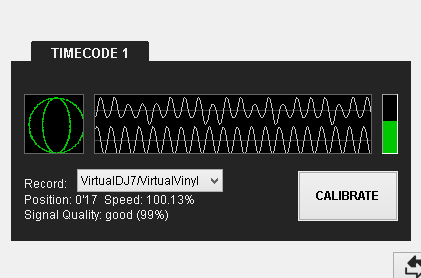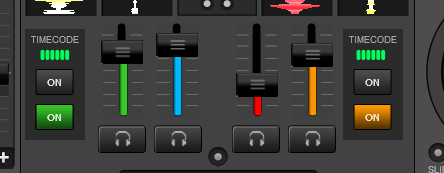Pioneer DDJ-SZ
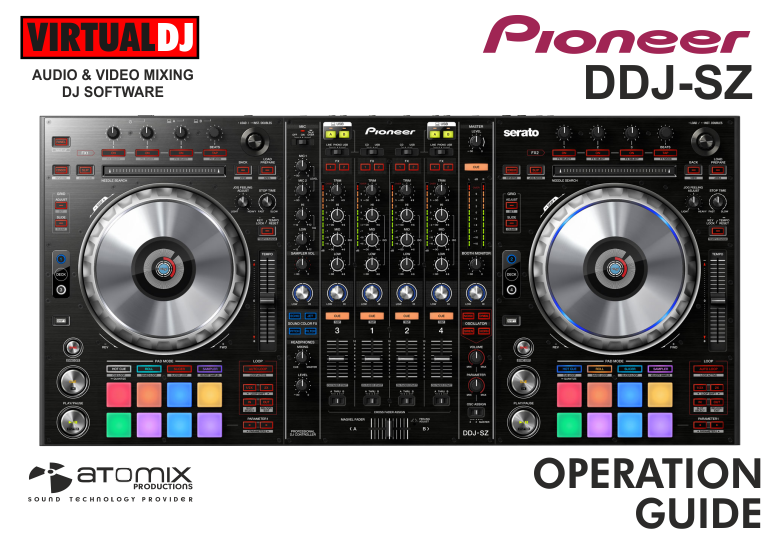
INSTALLATION
Firmware & Drivers
Firmware: Update the firmware of the unit to the latest version from http://www.pioneerdj.com/en/support/software/ddj-sz/#firmware-update
Drivers: Install the latest drivers (for both Windows and Mac OSX computers) from http://www.pioneerdj.com/en/support/software/ddj-sz/#drivers
VirtualDJ 8 Setup
Once VirtualDJ 8 is launched, a Login Window will appear. Login with your virtualdj.com account.
A Pro Infinity or a Subscription License is required to fully use the Pioneer DDJ-SZ. Without any of the above Licenses, the controller will operate for 10 minutes each time you restart VirtualDJ.
http://www.virtualdj.com/buy/index.html

Click on the "Use Soundcard" button in order VirtualDJ to apply the pre-defined audio configuration. Keep in mind that due to the nature of the unit, speakers need to be connected to the Master Output of the DDJ-SZ and the pre-defined audio configuration to be used.
Click on the Change Skin button to automatically load the default 4 decks skin of VirtualDJ 8,
Click to OK.
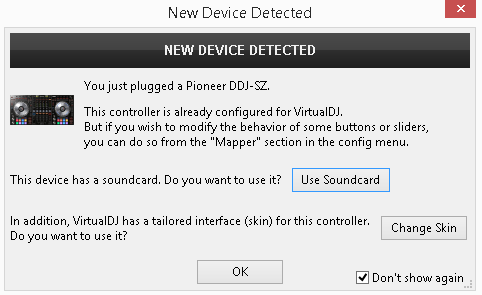
The unit is now ready to operate.
MIDI Operation
Find more details at
http://www.virtualdj.com/wiki/VDJ8script.html
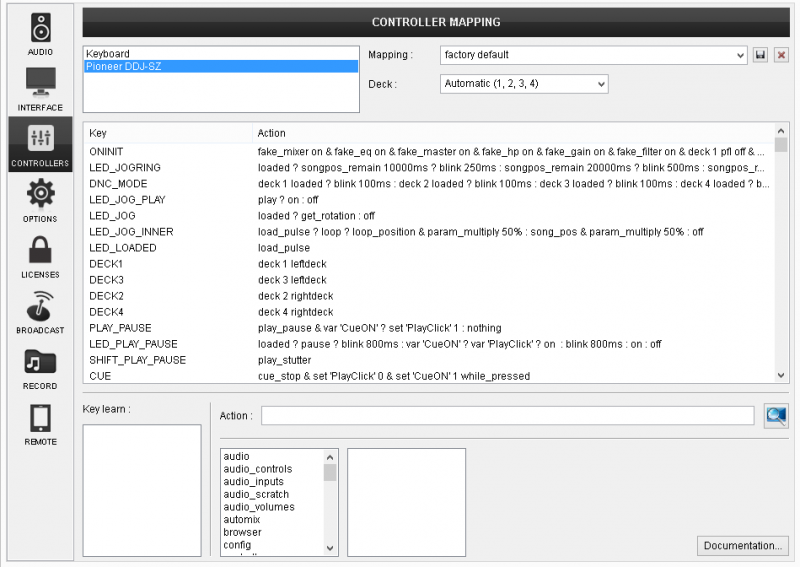
AUDIO Setup
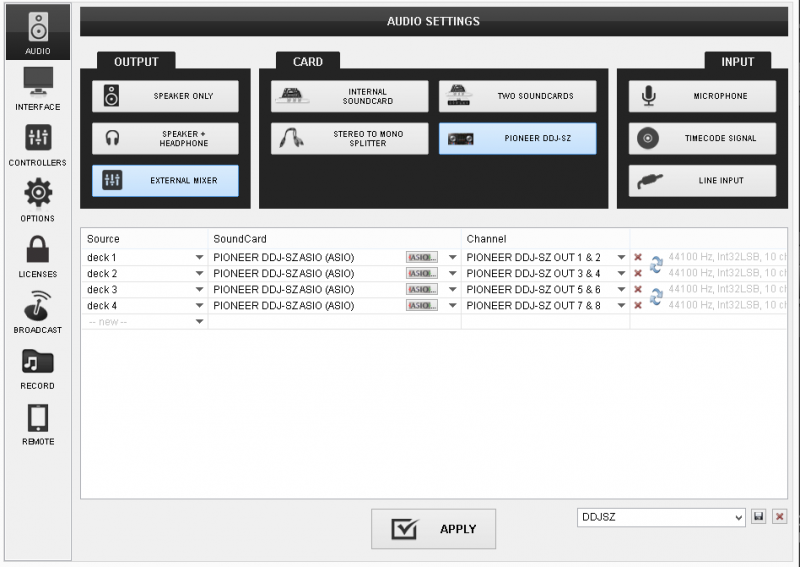
For further software settings please refer to the User Guide of VirtualDJ 8.
http://www.virtualdj.com/manuals/virtualdj8/index.html
MIXER
The mixer part of the PIONEER DDJ-SZ is a hardware mixer and the audio routing is done internally. Every button, knob and slider is MIDI capable, however only some of them are assigned with VirtualDJ script actions, therefore some parts will not be visible moving on the GUI of VirtualDJ.
Note that even some parts control the GUI of VirtualDJ, those do not alter the internal software mixer. It is strongly advised not to assign any VirtualDJ script action (other than the default ones) to any other part of the mixer.

- HEAPHONES LEVEL. Adjust the Volume Output of the Headphones Channel. Hardware operation, but movement visible on the GUI.
- HEADPHONES MIXING. Adjust how the Channels and the Master Output blend at the Headphones Channel. Hardware operation, but movement visible on the VirtualDJ GUI.
- SOUND COLOR FX. Select one of the predefined Color Effects (Echo, Jet, Pitch and Filter). Note that these Effects are hardware effects, and will not apply/control any VirtualDJ internal effects, nor the selection will be visible on the VirtualDJ GUI.
- SOUND COLOR FX PARAMETER. Adjust the parameter of the selected COLOR FX for each channel, MIC or Master. When in middle position, the COLOR FX has no effect on the sound. The movements are visible on the VirtualDJ GUI, (FILTER knob), however those are hardware operations.
- SAMPLER VOLUME. Adjust the Master Output Volume of the VirtualDJ Sampler
- MIC SECTION. Adjust the Volume Level, the HIGH and LOW frequency of MIC1 and MIC2 Inputs of the DDJ-SZ (Hardware operation)
- USB. Define if the Left channels of the DDJ-SZ mixer will be controlled by the computer connected to the USB A port.
- INPUT SELECTORS. Define the source of each Channel. Put the switchers to USB position for software mixing.
- USB. Define if the Left channels of the DDJ-SZ mixer will be controlled by the computer connected to the USB A port.
- MASTER VOLUME. Adjust the level of the Master Output. Hardware operation but movement visible on the VirtualDJ GUI
- FX ASSIGN. Use these buttons to copy (clone) the selected Effects from one deck to another. See EFFECTS
- MASTER CUE. Press this button to send the Master Output to the Headphones channel (Hardware operation)
- TRIM. Adjust the Gain of each mixer channel. Hardware operation but movement visible on the VirtualDJ GUI. Note that the applied gain is not altering the software gain of the internal mixer.
- HIGH/MID/LOW (EQ). Adjust the High, Mid and Low frequencies for each mixer channel. Hardware operation but movement visible on the VirtualDJ GUI.
- BOOTH MONITOR. Adjust the level of the Booth Output of the DDJ-SZ. Hardware operation, not visible on the VirtualDJ GUI.
- CUE (per channel) Press these buttons to send each channel to the Headphones Output channel. Hardware operation, not visible on the VirtualDJ GUI.
- VOLUME. Adjust the Volume of each channel. Hardware operation but movement visible on the VirtualDJ GUI. While SHIFT is held down, the VOLUME faders will stop the deck at the previously selected Cue when these reach the minimum level (zero) and will start the deck (synced to the other deck) if those move from the zero position. (Fader Start)
- CROSSFADER CH ASSIGN. Define if a mixer channel will be output regardless of the position of the crossfader (THRU position) or Left/Right. Hardware operation.
- OSCILATOR. Internal OSCILATOR generator of the DDJ-SZ. Hardware operation, not visible on the VirtualDJ GUI nor affect the software Sampler. Read further details on the unit’s operation manual.
- CROSSFADER. Blends audio between the channels assigned to the left and right side of the crossfader. Hardware operation, but movement visible on the VirtualDJ GUI.
C. DECKS
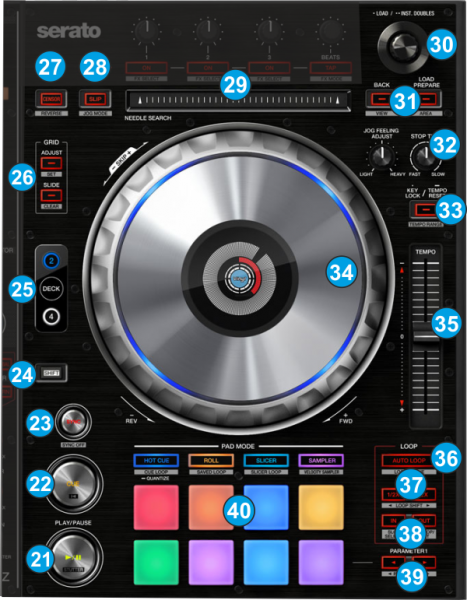
- PLAY. Plays / Pauses the track. Press and hold Shift and then press this button to "stutter-play" the track from the last set Cue Point.
- CUE. When the Deck is paused, you can set a temporary Cue Point by moving the Platter to place the Audio Pointer at the desired location and then pressing the Cue Button. During playback, you can press the Cue Button to return the track to this Cue Point. (If you did not set a Cue Point, then it will return to the beginning of the track.). If the Deck is paused, you can press and hold the Cue Button to play the track from the Temporary Cue Point. Releasing the Cue Button will return the track to the temporary Cue Point and pause it. To continue playback without returning to the Temporary Cue Point, press and hold the Cue Button, then press and hold the Play Button, and then release both buttons.
Press and hold Shift and then press this button to return to the beginning of the track. - SYNC. Press this button to automatically match the corresponding Deck's tempo with the opposite Deck's (or the Master Deck’s if using a 4 decks Skin) tempo and phase. Press and hold Shift and press this button to set this deck as Master Deck (for 4 decks skins).
- SHIFT. Press and hold this button to access secondary functions (in white box) of other controls on the DDJ-SZ
- DECK SELECT. Switch Left decks (1 and 3) and Right Decks (2 and 4).
- GRID
ADJUST. Press and hold this button and then move the JOGWHEEL to adjust the width of the CGB of the track (equal to adjust the BPM of the track). If SHIFT is held press this button to set the current position of the track as the First Beat.
SLIDE. Press and hole this button and then move the JOGWHEEL to shift the position of the CGB of the track - CENSOR. Press and hold this button to play the track backwards. On release the track will continue from the position it would have been if the button was never pressed. If SHIFT is held down, press this button (momentarily) to play the track backwards. Press again to play forward again.
- SLIP. Enables Slip Mode. Several software functions (such as Jogwheel movements, HotCues and Loops) will apply temporary on the track, and the track will return to the position it would have been when those functions are not triggered. If SHIFT is held, press this button to toggle between the Scratch and Bend Jogwheel modes.
- STRIP SEARCH. The length of this strip represents the length of the entire track. Place your finger on a point along this sensor to jump to that point in the track (song position).
- BROWSE
Knob: Scrolls through files or folders.
Push. Load the selected track to the deck - BACK. Sets focus to the Folders list. If focus is on the Folders list, it opens-closes subfolders.
VIEW. If SHIFT is held, it cycles though the available Sideview lists (Automix, Sidelist, Karaoke, Sampler and Clone).
LOAD PREPARE. Adds the selected track from the Songs List to the Automix List.
AREA. If SHIFT is held, press this button to cycle focus through the available Browser windows (Folders, Songs, SideView). - STOP TIME. Adjust the time that the track will take to stop completely when paused.
- KEYLOCK. Press this button to "lock" the track's pitch to its original key. The track's tempo will remain at the speed designated by the Pitch Fader. Press and hold the button for more than 1 second to smoothly reset the Pitch of the track to zero (original tempo). Hold SHIFT and then press this button to cycle through the available pitch ranges.
- JOGWHEEL. Touch sensitive platter for scratching (vinyl mode), bending (CD Mode) or Grid adjust. The white inner leds will rotate according to the software jogwheel position. The outer white/blue leds will start blinking if the track reaches 30 seconds before end. The inner Red ring indicates the track’s progress and the loop position bar if a Loop is active.
- PITCH. Controls the track's playback tempo. The Up and Down Arrow LEDs will flash if the pitch position of the unit and the actual pitch of the software do not match. While those flash, the pitch slider of the DDJ-SZ will not control the pitch of the deck until it meets the software value (soft take-over).
- AUTOLOOP Sets an Auto Loop. Hold SHIFT and press the same button to activate a Saved Loop.
- HALF/DOUBLE. Halves/Doubles the size of the Loop. Hold SHIFT and press the 1/2X or 2X buttons to move the triggered loop forward or backwards (step is relative to the length of the loop)
- IN/OUT. Use these buttons to set a Loop In and a Loop Out point (for manual looping). Hold SHIFT and press the
- PARAMETER. Offer various operations, depending on the PADs Mode (see PADS)
- PADS. Offer various operations, depending on the PADs Mode (see PADS)
EFFECTS
 The Left FX section (FX1) controls by default the effects of the Left selected software deck (1 or 3) and the Right FX section (FX2) controls by default the effects of the Right selected software deck (2 or 4) respectively. Use the FX ASSIGN (11) buttons to clone (copy) the Effects from one to another.
The Left FX section (FX1) controls by default the effects of the Left selected software deck (1 or 3) and the Right FX section (FX2) controls by default the effects of the Right selected software deck (2 or 4) respectively. Use the FX ASSIGN (11) buttons to clone (copy) the Effects from one to another.Each one of the FX unit offers 2 modes. The Single Effect mode offers one effect slot but more parameters controls per effect. The Multi Effects mode offers 3 effect slots (to trigger more than 1 effect at the same time – chained effects). The selection between those 2 modes is done by pressing the TAP while SHIFT is held.
- FX1 knob.
In Single FX mode, controls the 1st effect parameter of the selected effect. Hold SHIFT to control the 4th effect parameter of the selected effect (if available).
In Multi FX mode, controls the 1st effect parameter of the selected effect of slot 1. Hold SHIFT to control the 2nd effect parameter of the selected effect of slot 1. - FX2 knob.
In Single FX mode, controls the 2nd effect parameter of the selected effect. Hold SHIFT to control the 5th effect parameter of the selected effect (if available).
In Multi FX mode, controls the 1st effect parameter of the selected effect of slot 2. Hold SHIFT to control the 2nd effect parameter of the selected effect of slot 2. - FX3 knob.
In Single FX mode, controls the 3rd effect parameter of the selected effect. Hold SHIFT to control the 6th effect parameter of the selected effect (if available).
In Multi FX mode, controls the 1st effect parameter of the selected effect of slot 3. Hold SHIFT to control the 2nd effect parameter of the selected effect of slot 3. - BEATS. Use this knob to move the track one beat forward/backward. Press SHIFT and then use this knob to move the track 4 beats forward/backwards.
- FX1 ON.
In Single FX mode, press this button to enable/disable the selected effect. Press SHIFT and then this button, to enable/disable the 1st effect button of the selected effect (if available).
In Multi FX mode, press this button to enable/disable the selected effect of slot 1. Press SHIFT and then this button, to select the next available effect for slot 1. - FX2 ON.
In Single FX mode, press this button to select the previous effect from VirtualDJ Effects list. Press SHIFT and then this button, to enable/disable the 2nd effect button of the selected effect (if available).
In Multi FX mode, press this button to enable/disable the selected effect of slot 2. Press SHIFT and then this button, to select the next available effect for slot 2. - FX3 ON.
In Single FX mode, press this button to select the next effect from VirtualDJ Effects list. Press SHIFT and then this button, to enable/disable the 3rd effect button of the selected effect (if available).
In Multi FX mode, press this button to enable/disable the selected effect of slot 3. Press SHIFT and then this button, to select the next available effect for slot 3. - TAP. Press this button to manually tap the tempo of the track. Press SHIFT and then this button to toggle between the Single and Multi Effect modes.
PADS
Pads (40) offer 10 different modes, depending on the PAD MODE buttons. Each of the 4 PAD MODE buttons offers 2 individual modes (hold SHIFT and then press the PAD MODE button to access the additional mode).
HotCues mode
Press the HOT CUE button to set the PADs to HOT CUE mode. Press and hold the same button for more than 1 second to enable/disable the Smart Cue (Quantize)
Each one of the 8 pad assigns a Hot Cue Point or returns the track to that Hot Cue Point.
When a Hot Cue Button is unlit, you can assign a Hot Cue Point by pressing it at the desired point in your track. Once it is assigned, the Hot Cue Button will light white.
Hold SHIFT and then press a pad to delete its assigned Hot Cue Point. Leds will be red if a HotCue point exists
The PARAMETER buttons (41) jump the song to the previous/next assigned HotCue point. Hold SHIFT and then press the PARAMETER buttons (41) to select between the Normal and the Stutter HotCue mode. On Stutter mode, when the track is paused, the HotCues act temporary (preview the track while pressed).
HotCues- Loop mode
Hold SHIFT and then press the HOT CUE button to set the PADs to CUELOOP mode.
Each one of the 8 pad assigns a Hot Cue Point or returns the track to that Hot Cue Point, but in both cases, it also triggers a Loop at that point.
The Loop length can be adjusted by the LOOP 1/2X and 2X buttons.
Press and hold SHIFT and then press a pad to delete its assigned Hot Cue Point
The PARAMETER buttons (41) jump the song to the previous/next assigned HotCue point. Hold SHIFT and then press the PARAMETER buttons (41) to select between the Normal and the Stutter HotCue mode. On Stutter mode, when the track is paused, the HotCues act temporary (preview the track while pressed).
Roll – Loop mode
Press the ROLL button to set the PADs to ROLL mode.
Each one of the 8 pad triggers a momentary Loop Roll. The size of the Loop Roll varies (see image). When a Loop Roll is triggered, the waveform of the track on the VirtualDJ GUI will continue to indicate the exit point.
Press SHIFT then one of the pads to trigger a Loop of a different size (see image).
3 Loop Size banks are offered (Small, Normal and Large), defined by the PARAMETER buttons.
Hold SHIFT and then press the PARAMETER (–) button to select the Small loop size bank.
Hold SHIFT and then press the PARAMETER (+) button to select the Large Loop size bank. Use the same buttons to return to the Normal loop bank (the leds of both PARAMETER buttons will be off in Normal mode)
Saved Loops mode
Hold SHIFT and then press the ROLL button to set the PADs to SAVED LOOP mode.
Each one of the 8 pad offers a slot to save the current selected loop. Press once to save the current loop to the first available slot (led becomes orange). Press the same pad to load and prepare the Loop. (it will not jump to that point if the position of the track is before that point).
Press SHIFT and then a saved slot to activate the Loop and jump the track to that point. Press the same pad to disable the Loop
Use the left PARAMETER button to save the current Loop to the first available slot. Use the right PARAMETER button to delete the last saved slot.
Slicer & Slicer Hold mode
Press the SLICER button to set the PADs to SLICER mode.
The eight pads represent eight sequential beats—"Slices"—in the Beat Grid. The currently playing Slice is represented by the currently red lit pad. The red light will "move through the pads" as it progresses through each eight-Slice phrase. Press a pad to repeat that Slice (hold it down if you want to keep looping it).
Once the Pad is released the track will continue to play from the position it would have been if the pad was never pressed.
Press SHIFT and then the SLICER button to set the PADs to SLICER HOLD mode. In this mode the Slice is memorized on first press as the track continues to play. (HOLD mode)
Use the PARAMETER button to adjust the length of the Loop applied to the slice. Press SHIFT and then the PARAMETERS buttons to adjust the step of the Slices
Sampler & Sampler Velocity mode
Press the SAMPLER button to set the PADs to SAMPLER mode.
Each one of the pads trigger a sample from the selected Sampler Bank of VirtualDJ. If a bank has less than 9 samples, both sides of the DDJ-SZ will control the same samples. If a bank has more than 8 samples, the left side of the DDJ-SZ will control samples 1 to 8 and the right side samples 9 to 16. Each one of the Pads will automatically get the assigned color of each sample.
Press the pads to trigger a sample. Depending on the selected trigger mode, use SHIFT and the same pads to stop the sample.
Use the PARAMETER buttons to select the Sampler Bank (previous/next). Press SHIFT and then the PARAMETERS buttons to select the Trigger Pad mode (on/off, hold, stutter, unmute)
Press SHIFT and then the SAMPLER button to set the PADs to SAMPLER Velocity mode. In this mode the Pads will additionally adjust the Volume of the Samples depending on the pressure (velocity) when triggered.
Recording
The sound is mixed internally with the DDJ-SZ mixer, so with the pre-defined audio configuration, the recording process within VirtualDJ will not provide the expected results. However, the DDJ-SZ sound card offers a dedicated sound card input which can be used to record (and/or broadcast) your mix along with the Microphone Inputs of the DDJ-SZ.
How to:
- Open the AUDIO tab of the VirtualDJ 8 Config window, and manually add a record line as per the image below.
- Click APPLY.
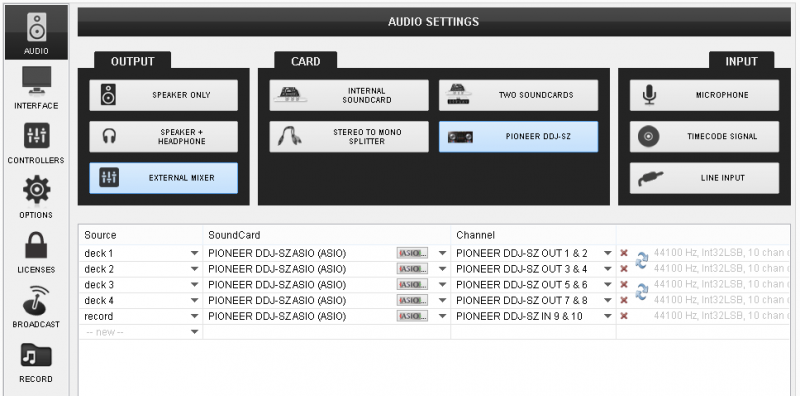
For the recording to properly working, you need to make sure USB Channels 9,10 are set to MIX (REC-OUT), as per the image below.
The DDJ-SZ Utility Settings is available at the following location :
Mac : [Application] > [Pioneer] > [DDJ-SZ] > [DDJ-SZ Settings Utility].
Windows: [Start] menu > [All Programs] > [Pioneer] -> [DDJ-SZ] -> [DDJ-SZ Settings Utility].
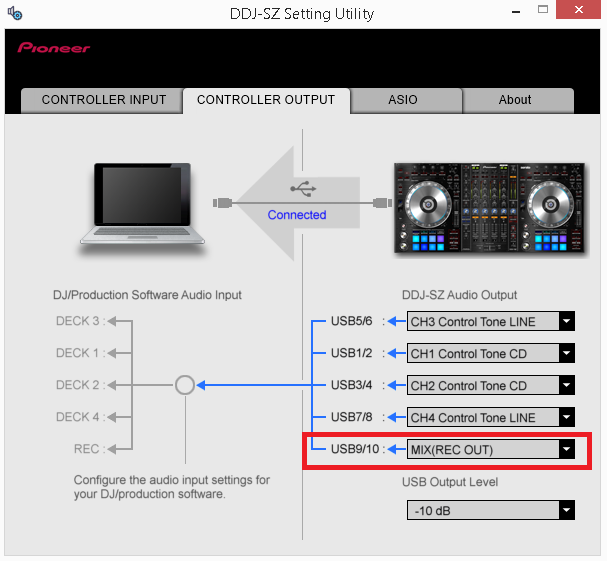
TIMECODES (DVS)
The DDJ-SZ is offering DVS (Digital Vinyl System) support with VirtualDJ 8. Up to 4 Timecode Inputs can be assigned and control up to 4 software decks via Timecode CDs or Vinyls. Mixer Channels 1 and 2 can accept LINE Sources (Timecode CDs), and Channels 3 and 4 can accept both LINE and PHONO Sources (Timecode CDs and Timecode Vinyls) depending on the rear connections.
On the right-sided image the Outputs 5/6 (Channel mixer 3) and 7/8 (Channel mixer 4) have been assigned as LINE Sources (for Timecode CDs). Set those to PHONO if you have connected Timecode Vinyls to those Inputs.
Make sure the Channel Input Assign switchers at the top of the DDJ-SZ are set to USB position (or else the Timecode signal will be routed directly to the Master Output)

Below is an example of 2 Timecode Inputs, which can be assigned to control any left or right deck of VirtualDJ, by using the TC buttons in the SCRATCH center panel.
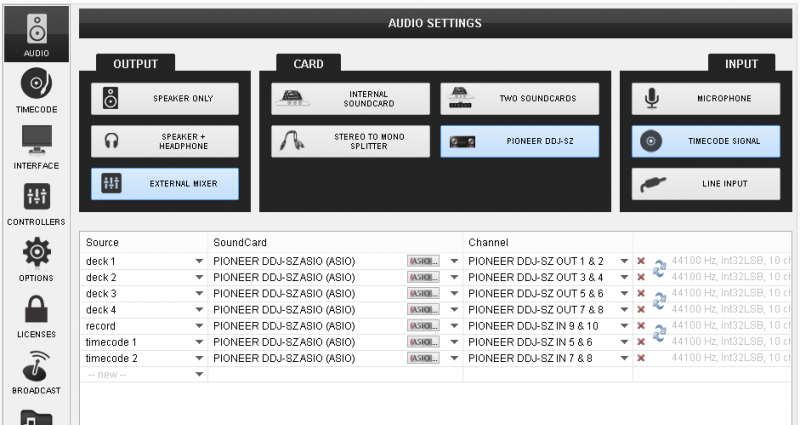
Once the above Audio configuration is set, click to APPLY and then open the new TIMECODE tab of the Config you will see in the Config window. Press PLAY on your timecode CD or Vinyl device and VirtualDJ will automatically detect your Timecode type and make the appropriate adjustments for best performance. Choose the CALIBRATE button if for any reason the signal is not detected (possibly due to reversed phase connections).
